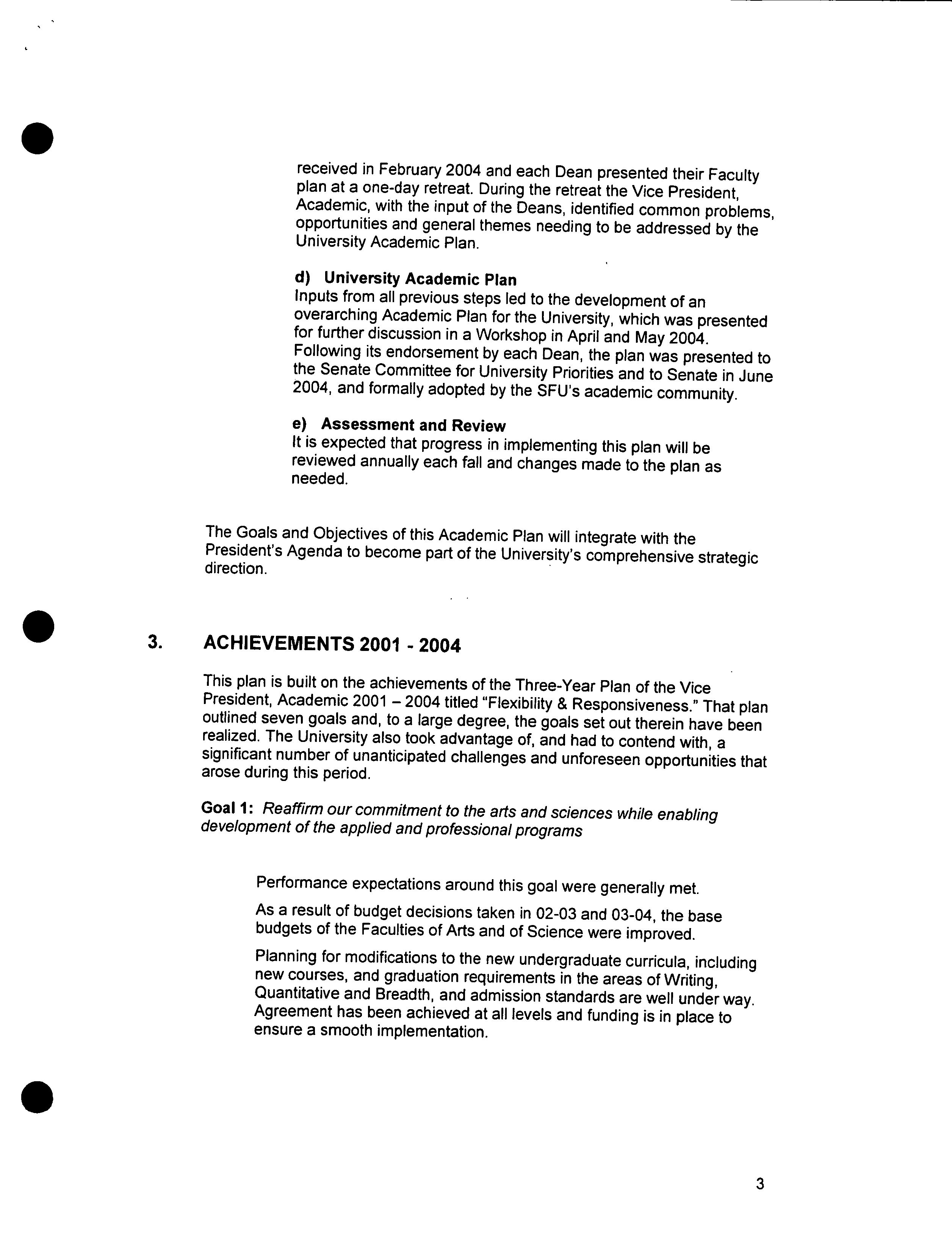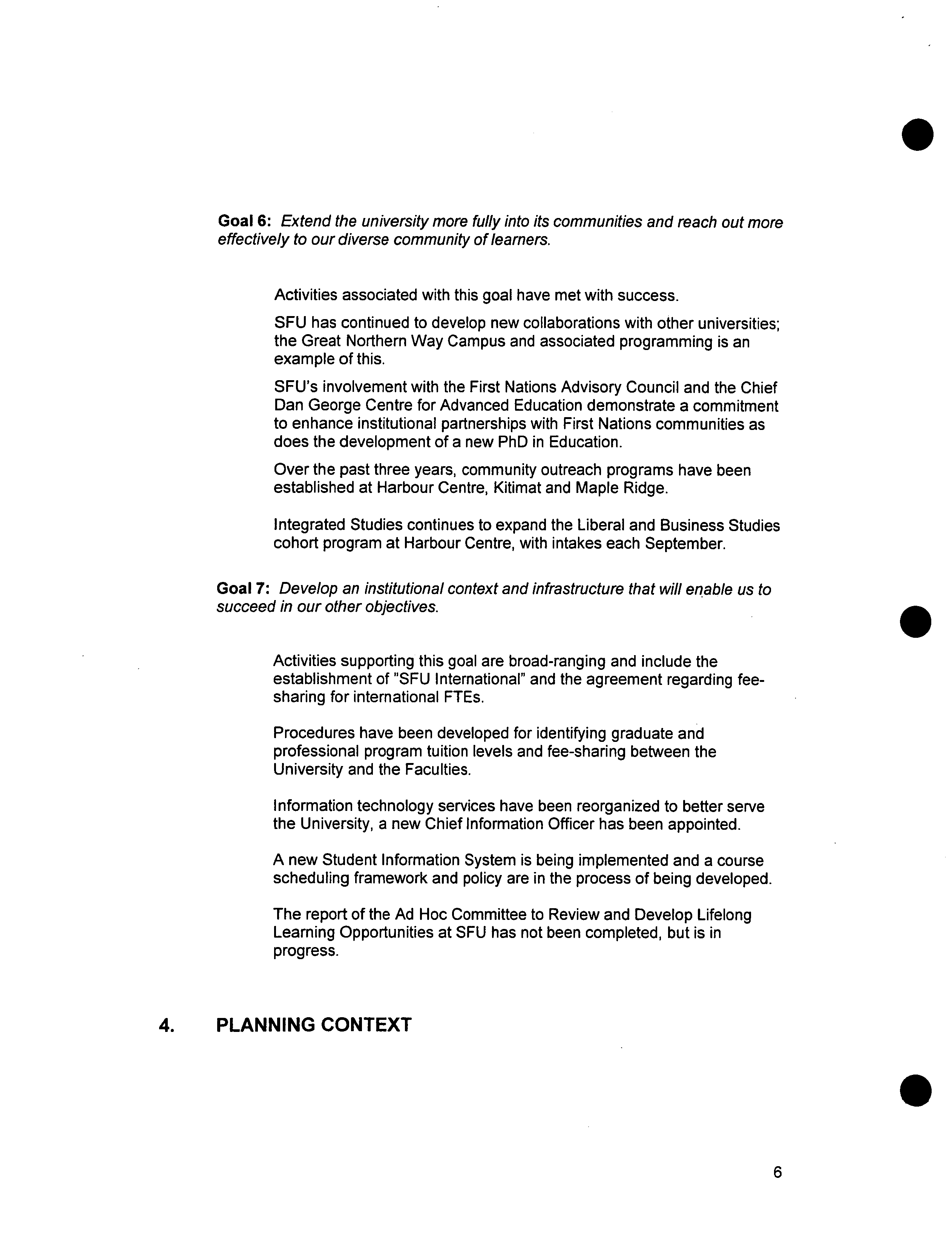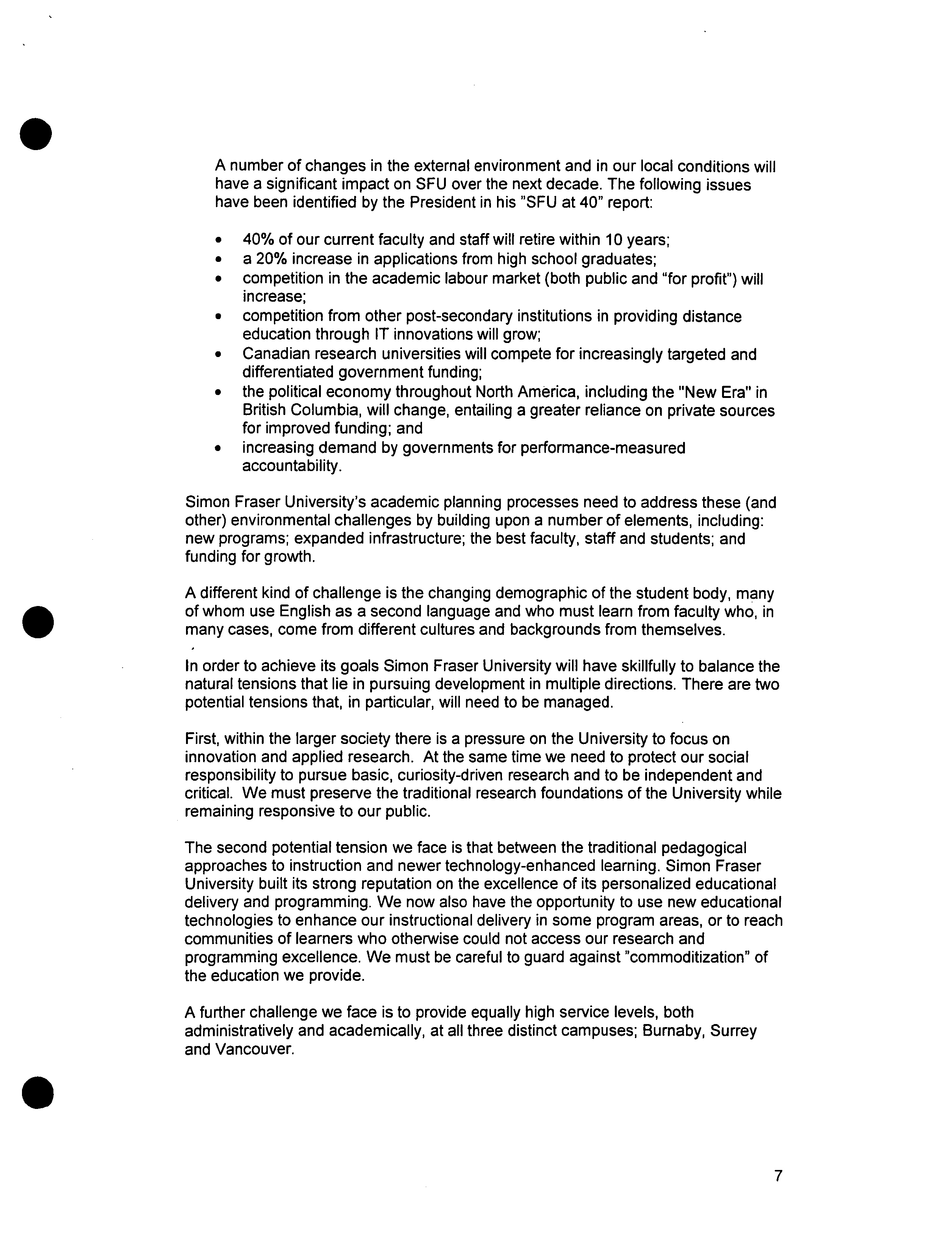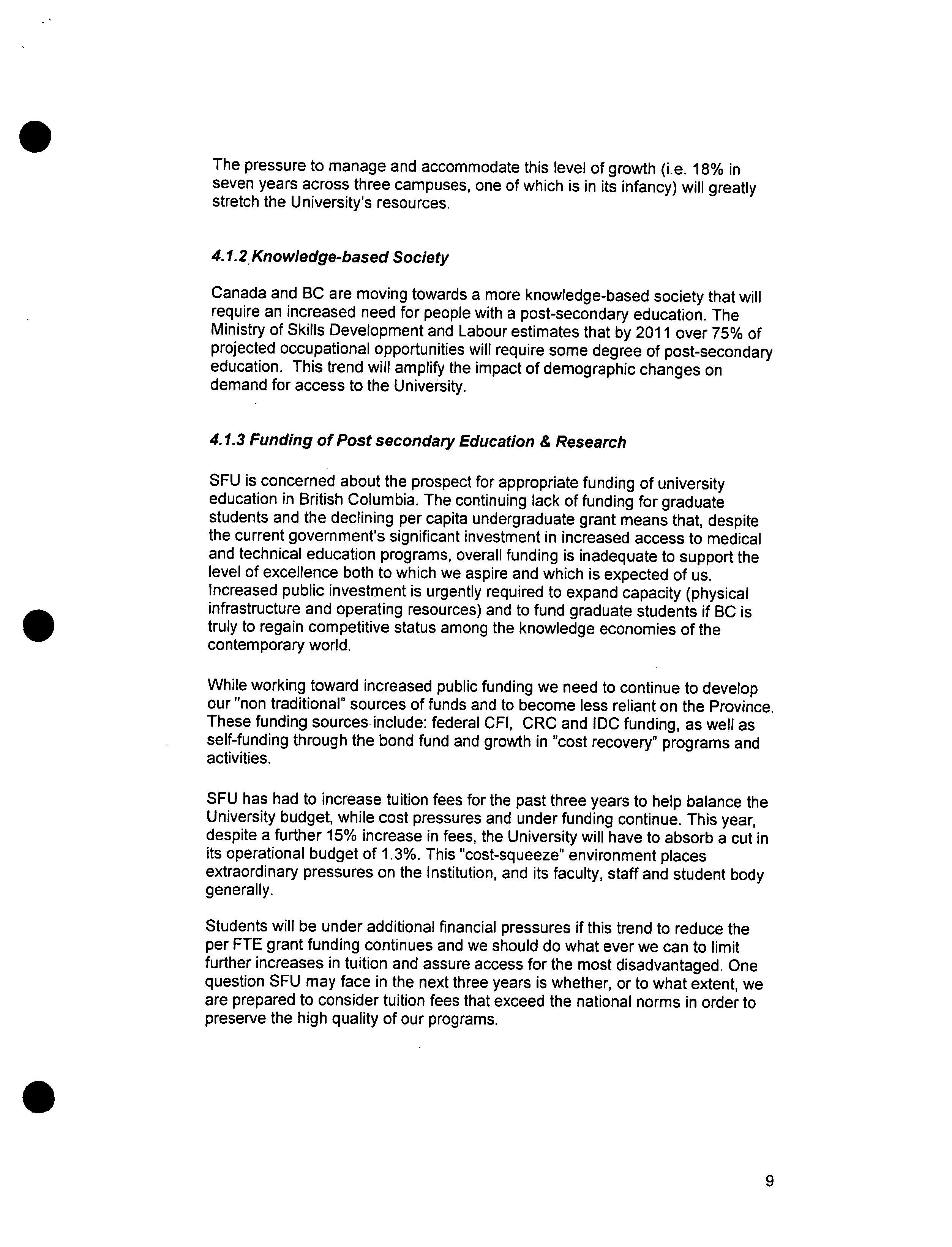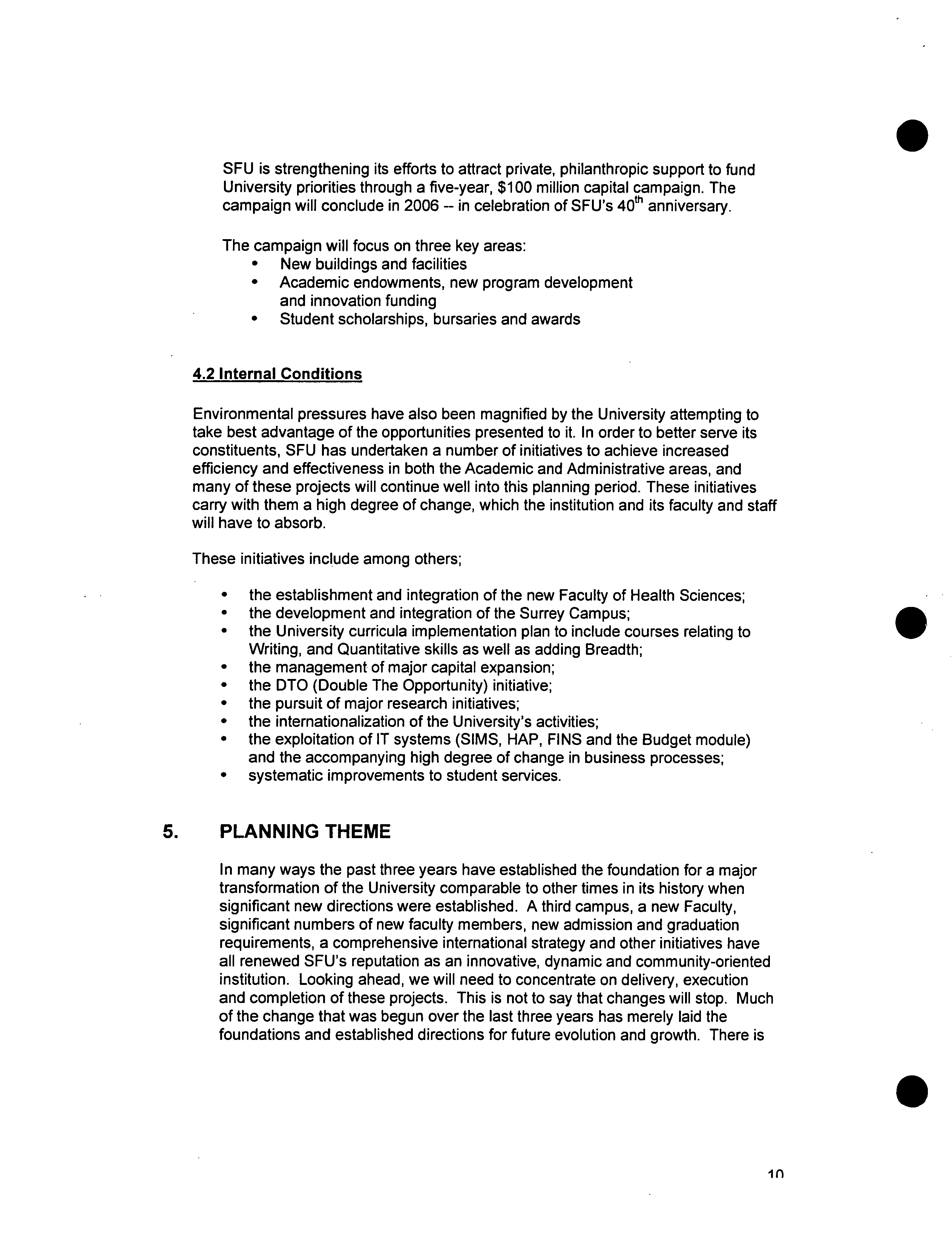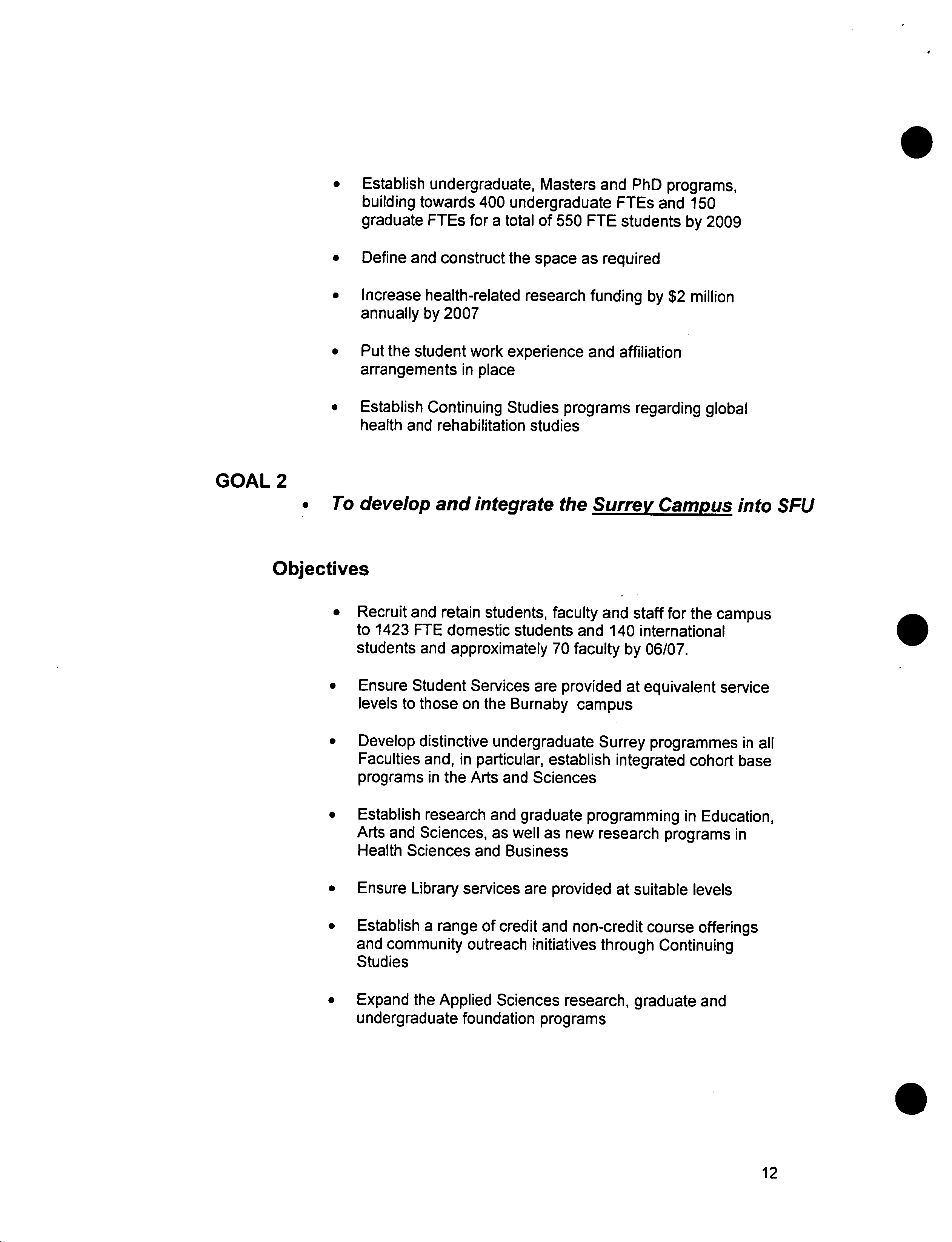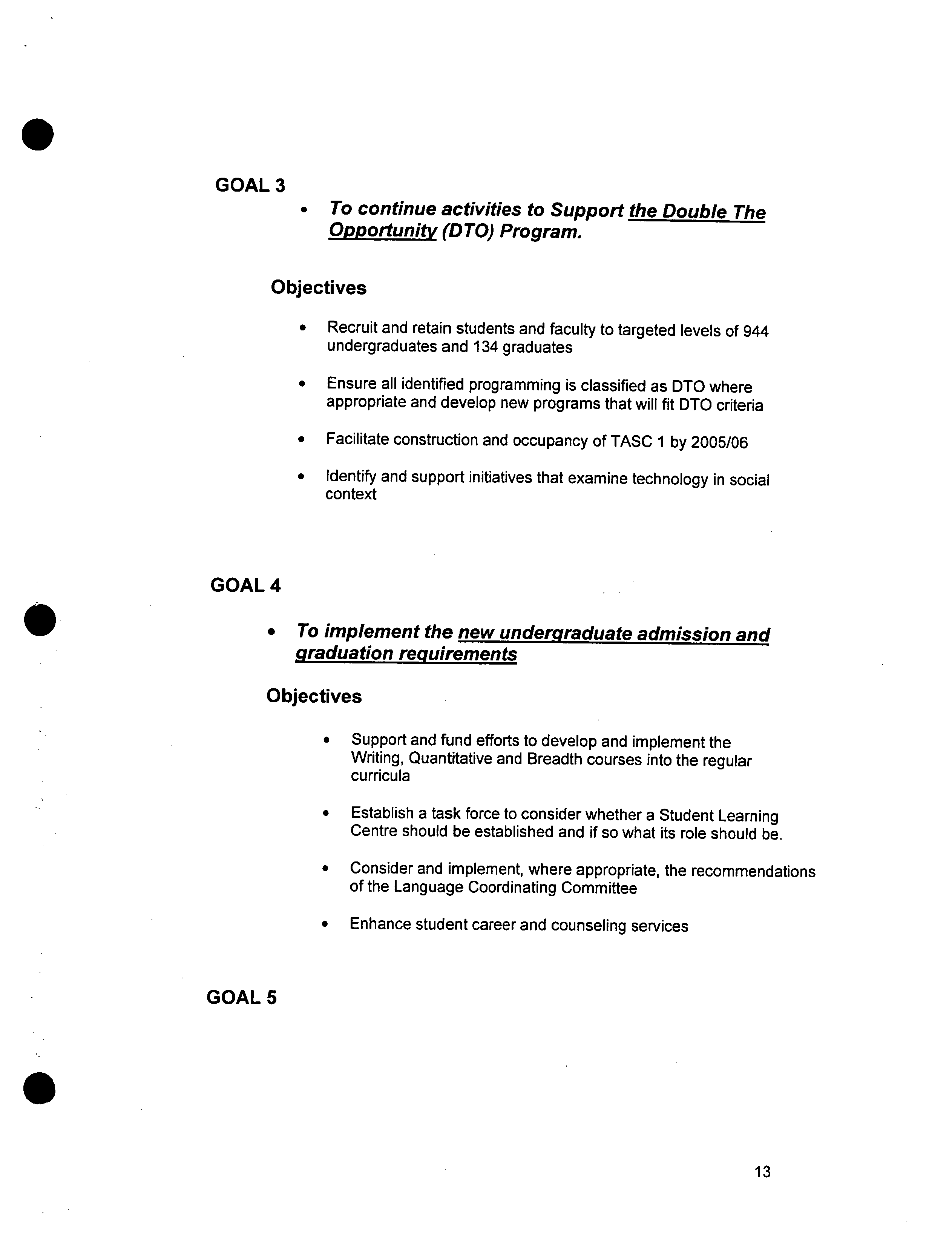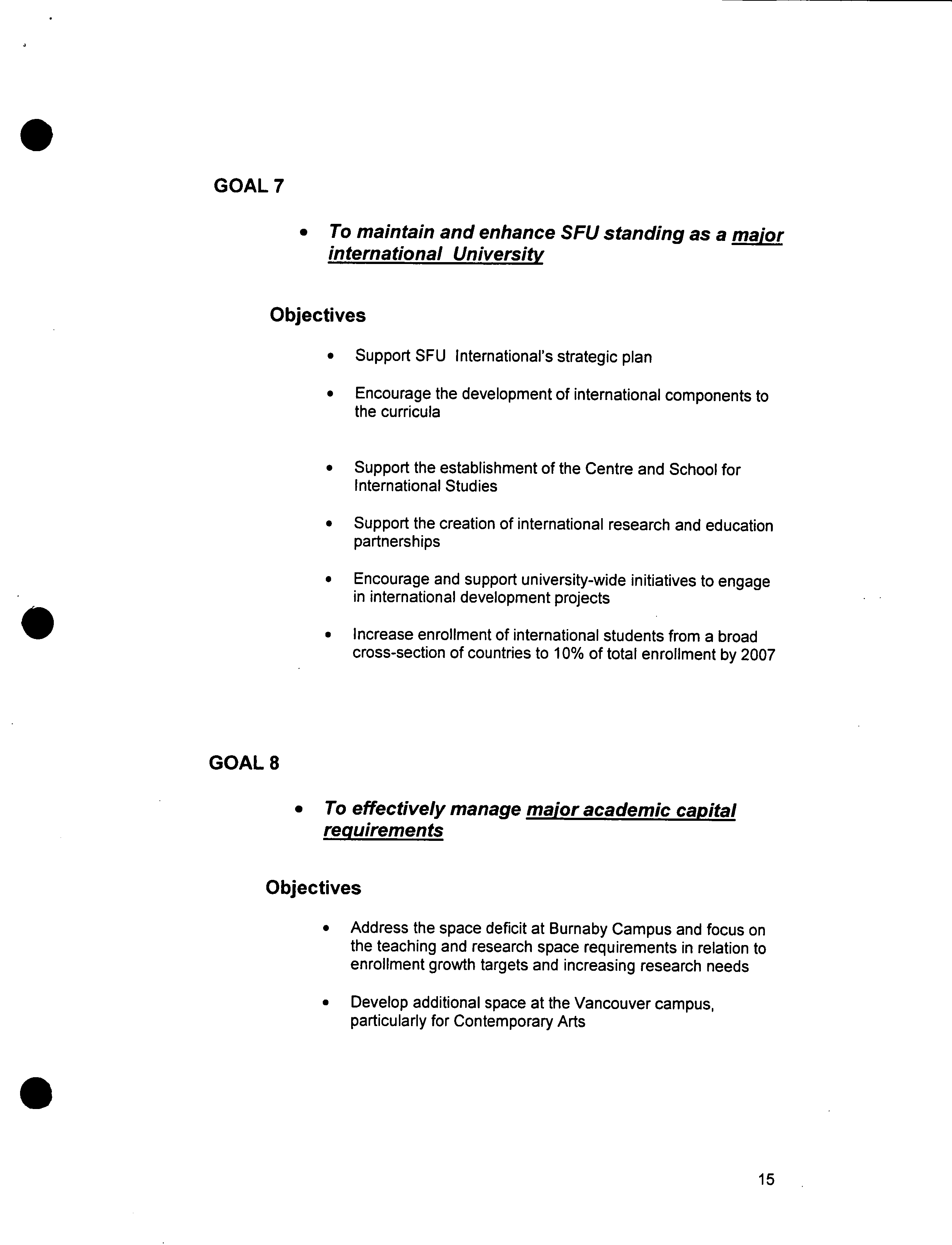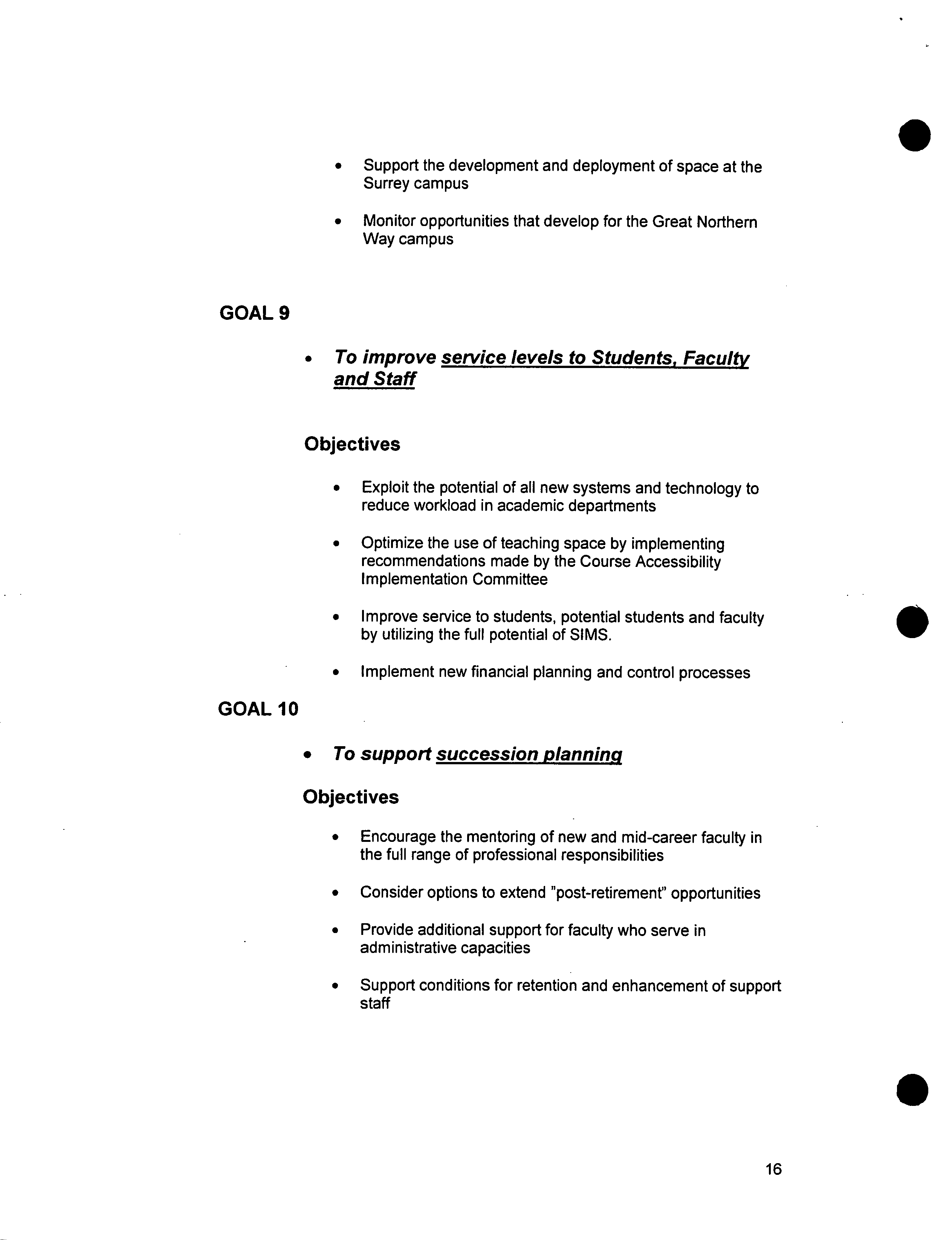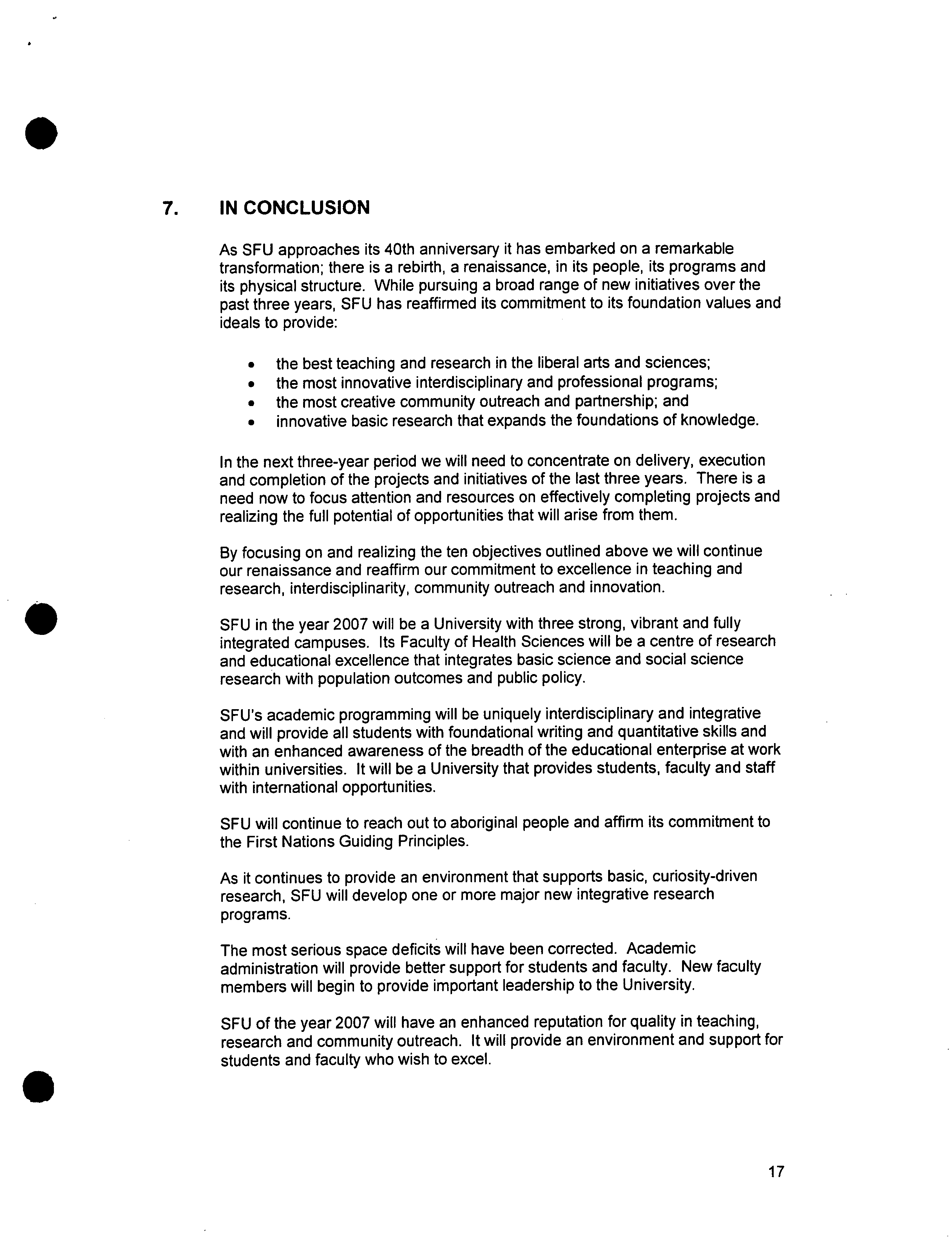SIMON FRASER UNIVERSITY ?
S.0442
.
?
Senate Committee on University Priorities
Memorandum
TO:
Senate ?
FROM: ?
John Waterhou,s
Chair, SCUP/
e
?
ca em c
Vice
?
sid
ca emic
RE:
Three Year Academic Plan
?
DATE: ?
May 20,
7
For Information
On behalf of the Senate Committee on University Priorities (SCUP) I would like to
submit to Senate for information the Simon Fraser University Three Year Academic
Plan for the period 2004 - 2007. SCUP reviewed and approved the document at its
May 12, 2004 meeting.
end.
S
0
SCUP O4-021
THREE YEAR ACADEMIC PLAN
2004-2007
SIMoN F1tASE11,
•
I w15
?
U'Niv
RSITY
41
THREE YEAR ACADEMIC PLAN
1.
INTRODUCTION
As it approaches the
401h
anniversary of its establishment Simon Fraser
University's achievements reflect the development of a unique institutional
culture forged in the tumultuous '60s and now defined in the University's
Statement of Values and Commitments: SFU is distinctive in the depth of its
commitment to intellectual and academic freedom; to openness and inclusion in
order to assure these commitments; the value it places on responsiveness to the
community; its belief in the interconnectedness of discovery, diversity and
dialogue; and its willingness to encourage risk and innovation.
These values and commitments must anchor any agenda for the Academic Plan
as we continue to find ways to provide
• the best teaching and research in the liberal arts and sciences;
• the most innovative interdisciplinary and professional programs; and
• the most creative community outreach and partnership.
When doing so, we also must continue to champion the value of curiosity-driven,
basic research in expanding the foundations of knowledge.
2.
PLANNING PROCESS
?
0
This planning cycle consisted of three steps;
a) Planning Retreat.
A one day planning Retreat was held in April 2003. The Deans and
the Vice President, Academic, the Associate Vice President,
Academic and their staff developed a number of Operational
Principles which would guide the planning process. Also confirmed
was a time line for the planning process.
b)
Achievements 2001 - 2004.
The last Academic Plan was reviewed and an assessment
conducted of how the goals set out there had been achieved and/or
addressed (see 3 below).
C)
Faculty Planning 2004 - 2007.
In June 2003 each Faculty, plus other units that report to the Vice-
President, Academic, were formally asked to prepare new academic
plans for the period 2004 to 2007. In line with the guiding
operational principles developed in step 1, Faculties were asked to
identify academic areas of focus and priority that would guide the
allocation of resources. These plans also had to conform to the
Senate Guidelines for Academic Plans (S00.44a). Plans were
2
.
received in February 2004 and each Dean presented their Faculty
plan at a one-day retreat. During the retreat the Vice President,
Academic, with the input of the Deans, identified common problems,
opportunities and general themes needing to be addressed by the
University Academic Plan.
d)
University Academic Plan
Inputs from all previous steps led to the development of an
overarching Academic Plan for the University, which was presented
for further discussion in a Workshop in April and May 2004.
Following its endorsement by each Dean, the plan was presented to
the Senate Committee for University Priorities and to Senate in June
2004, and formally adopted by the SFU's academic community.
e)
Assessment and Review
It is expected that progress in implementing this plan will be
reviewed annually each fall and changes made to the plan as
needed.
The Goals and Objectives of this Academic Plan will integrate with the
President's Agenda to become part of the University's comprehensive strategic
direction.
0 ?
3. ACHIEVEMENTS 2001 - 2004
This plan is built on the achievements of the Three-Year Plan of the Vice
President, Academic 2001 - 2004 titled "Flexibility & Responsiveness." That plan
outlined seven goals and, to a large degree, the goals set out therein have been
realized. The University also took advantage of, and had to contend with, a
significant number of unanticipated challenges and unforeseen opportunities that
arose during this period.
Goal
1:
Reaffirm our commitment to the arts and sciences while enabling
development of the applied and professional programs
Performance expectations around this goal were generally met.
As a result of budget decisions taken in 02-03 and 03-04, the base
budgets of the Faculties of Arts and of Science were improved.
Planning for modifications to the new undergraduate curricula, including
new courses, and graduation requirements in the areas of Writing,
Quantitative and Breadth, and admission standards are well under way.
Agreement has been achieved at all levels and funding is in place to
ensure a smooth implementation.
.
Many new interdisciplinary courses have been developed and/or
enhanced, including those in the areas of Biotechnology, Business,
Biomedical Engineering, Cognitive Science and International Studies
New and applied programming has been achieved within a number of
areas, including the Master's in Public Policy, the Global Asset and
Wealth Management MBA and various courses in School of Interactive
Arts and Technology.
Programming for the new Faculty of Health Sciences is well underway
and the Faculty will become operational on September 1, 2004.
Goal 2:
Enhance our research excellence and profile
Expectations around this goal have been met, although it was not
possible at this time to sustain the Research Advisory Council.
Grant and Contract research funding has grown from $27 million in
2000/01 to $50 million in 2003/04. In addition CFI and KDF projects have
reached $23.8 million and SSHRC, INE and CURA grants reached
$11
million over three years.
We have been allocated 43 Canada Research Chairs and have
successfully identified additional funding to cover both the direct and
indirect costs of research. Grant funding has increased and a major CFI
stage.
Project is nearing completion while others are in the early planning
?
is
Goal 3:
Improve our ability to attract, retain, and support outstanding faculty.
Activities introduced to support this goal have been successful and
expectations have been met.
Various programs are in place to attract and retain outstanding faculty:
these include market differential funding, the establishment of the
retention fund, and a new faculty incentive fund. The President's
Research Grant has been maintained, and funding is also in place to
support new and existing scholars with regard to "startup" and retention.
Forty-four percent of new faculty hires have been attracted from outside
of Canada.
A number of programs are in place to support faculty in instructional
development. These include services provided by eLINC and LIDC
Orientation of new faculty and training for new Chairs have been
improved, as has the flow of information to Chairs.
S
4
Goal 4: Enhance our learning environments and instructional pedagogy so that
they demonstrate our excellence, innovation, and our ability to engage our
students.
This objective is being met and various actions continue to ensure that
SFU makes the most of opportunities to use the best technology for
instructional delivery.
SFU's approach to instructional delivery and learning technologies have
been evaluated and a new vision, strategy and structure are under
discussion.
LIOC has been successful in developing programs to enhance the
instructional skills of graduate students. Cooperative education
opportunities need to be more fully explored, but economic conditions in
BC are limiting at this time.
Increased opportunities for students to work and study internationally
have been identified and employed.
Goal 5:
Attract, retain and support outstanding students and identify ways to
enrich the learning experience of all students.
This is an ongoing goal and it remains a priority to seek ways to attract,
retain and support talented students.
Success has been achieved in a number of areas, including: the Senate
action on improving student recruitment, the expansion of a First Nations
Student Centre, and the increase in international student recruitment,
with a target now set at 10% of undergraduate enrollment.
The SIMS implementation is well underway and, despite the predictable
startup problems, it promises to meet expectations in providing web-
based access for student registration and other improvements to student
services.
A strategy is being prepared to expand the participation of First Nations
students at SFU.
The proposal for the creation of a Centre for New Students outlined in
the 2001/2004 plan has been re-evaluated and replaced with a Student
Development and Programming Centre focused, in the initial stages, on
new student orientation and mentorship programming.
The dynamic and aggressive approach taken in establishing a SFU
presence in Surrey also testifies to the desire of the University to serve
its communities.
fl
S
5
Goal 6:
Extend the university more fully into its communities and reach out more
effectively to our diverse community of learners.
Activities associated with this goal have met with success.
SFU has continued to develop new collaborations with other universities;
the Great Northern Way Campus and associated programming is an
example of this.
SFU's involvement with the First Nations Advisory Council and the Chief
Dan George Centre for Advanced Education demonstrate a commitment
to enhance institutional partnerships with First Nations communities as
does the development of a new PhD in Education.
Over the past three years, community outreach programs have been
established at Harbour Centre, Kitimat and Maple Ridge.
Integrated Studies continues to expand the Liberal and Business Studies
cohort program at Harbour Centre, with intakes each September.
Goal 7:
Develop an institutional context and infrastructure that will enable us to
succeed in our other objectives.
Activities supporting this goal are broad-ranging and include the
establishment of "SFU International" and the agreement regarding fee-
sharing for international FTEs.
Procedures have been developed for identifying graduate and
professional program tuition levels and fee-sharing between the
University and the Faculties.
Information technology services have been reorganized to better serve
the University, a new Chief Information Officer has been appointed.
A new Student Information System is being implemented and a course
scheduling framework and policy are in the process of being developed.
The report of the Ad Hoc Committee to Review and Develop Lifelong
Learning Opportunities at SFU has not been completed, but is in
progress.
4. ?
PLANNING CONTEXT
S
6
A number of changes in the external environment and in our local conditions will
have a significant impact on SFU over the next decade. The following issues
have been identified by the President in his 'SFU at 40" report:
• 40% of our current faculty and staff will retire within 10 years;
• a 20% increase in applications from high school graduates;
• competition in the academic labour market (both public and "for profit') will
increase;
• competition from other post-secondary institutions in providing distance
education through IT innovations will grow;
• Canadian research universities will compete for increasingly targeted and
differentiated government funding;
• the political economy throughout North America, including the 'New Era" in
British Columbia, will change, entailing a greater reliance on private sources
for improved funding; and
• increasing demand by governments for performance-measured
accountability.
Simon Fraser University's academic planning processes need to address these (and
other) environmental challenges by building upon a number of elements, including:
new programs; expanded infrastructure; the best faculty, staff and students; and
funding for growth.
A different kind of challenge is the changing demographic of the student body, many
S ?
of whom use English as a second language and who must learn from faculty who, in
many cases, come from different cultures and backgrounds from themselves.
In order to achieve its goals Simon Fraser University will have skillfully to balance the
natural tensions that lie in pursuing development in multiple directions. There are two
potential tensions that, in particular, will need to be managed.
First, within the larger society there is a pressure on the University to focus on
innovation and applied research. At the same time we need to protect our social
responsibility to pursue basic, curiosity-driven research and to be independent and
critical. We must preserve the traditional research foundations of the University while
remaining responsive to our public.
The second potential tension we face is that between the traditional pedagogical
approaches to instruction and newer technology-enhanced learning. Simon Fraser
University built its strong reputation on the excellence of its personalized educational
delivery and programming. We now also have the opportunity to use new educational
technologies to enhance our instructional delivery in some program areas, or to reach
communities of learners who otherwise could not access our research and
programming excellence. We must be careful to guard against "commoditization" of
the education we provide.
A further challenge we face is to provide equally high service levels, both
administratively and academically, at all three distinct campuses; Burnaby, Surrey
and Vancouver.
S
7
4.1 The External Environment
SFU operates within a dynamic environment, and the demands continue for the
University to deliver sustained service excellence to an ever-increasing constituency.
The surging demand for post-secondary education reflects both the growing
population and the increasing recognition that higher education is the key to success
in a knowledge-based society. These factors are complicated by reduced
Government funding, and universities are expected to do more with less. Our
challenge is to adapt, to innovate and to continue to face these hurdles with
confidence and enthusiasm. To do this we need a thorough understanding of the
environment and the impact it has and will have on us. To give some depth to the
broader understanding of our response, a summary of these conditions follows.
4.1.1 Demographic Changes
In the past five years, the Canadian population has grown by 3.6% and forecasts
for the year 2011 predict that an increase to 33.6 million or by 8.5% is probable.
Population growth in British Columbia continues to be high, fed by large-scale
immigration, particularly from other Pacific Rim countries. Of particular
importance to SFU is the projected number of young adults in the age group 18-
29 years, which is expected to grow from 671,466 in 2003/4 to 697,057 in
2006/07(3.81%), and by .2009/10 the forecast is 722,647, a total of 7.62% over
the six year period. This growth trend is expected to continue until 2014.
A report to the Ministry of Advanced Education drafted by SFU and three other
higher education institutions in the Fraser Region predicts an increase of 14,000
FTEs over the next eight years in our catchment area.
In response to these demographic pressures, the Ministry has awarded funding
for the further development of the SFU Surrey campus. We envisage enrollment
growing at both the Surrey and the Burnaby Campuses.
Taking this growth together with the increasing numbers of older students and
the accepted notion of "life-long learning," we need to prepare for increased
enrollment at SFU.
In line with this demographic change, the table below indicates that SFU is
expecting to increase undergraduate and graduate enrollments by 3000 (18%)
over the next six years.
SFU
Campus
current
2003104
2004/05
Growth
2005/06
Growth
2006/07
Growth
2007/08
Growth
2008/09
Growth
2009/10
Growth
Total
Growth
Total
2009/10
Surrey
650
210
235
328
359
359
359
1,850
2500
Burnaby
16200
429
182
109
142
142
146
1,150
17350
Total
16854
639
417
437
501
501
505
3,000
19850
0
.
The pressure to manage and accommodate this level of growth (i.e. 18% in
seven years across three campuses, one of which is in its infancy) will greatly
stretch the University's resources.
4. 1.2 Knowledge-based Society
Canada and BC are moving towards a more knowledge-based society that will
require an increased need for people with a post-secondary education. The
Ministry of Skills Development and Labour estimates that by 2011 over 75% of
projected occupational opportunities will require some degree of post-secondary
education. This trend will amplify the impact of demographic changes on
demand for access to the University.
4.1.3 Funding of Post secondary Education
&
Research
SFU is concerned about the prospect for appropriate funding of university
education in British Columbia. The continuing lack of funding for graduate
students and the declining per capita undergraduate grant means that, despite
the current government's significant investment in increased access to medical
and technical education programs, overall funding is inadequate to support the
level of excellence both to which we aspire and which is expected of us.
Increased public investment is urgently required to expand capacity (physical
• ?
infrastructure and operating resources) and to fund graduate students if BC is
truly to regain competitive status among the knowledge economies of the
contemporary world.
While working toward increased public funding we need to continue to develop
our "non traditional" sources of funds and to become less reliant on the Province.
These funding sources include: federal CFI, CRC and IDC funding, as well as
self-funding through the bond fund and growth in "cost recovery" programs and
activities.
SFU has had to increase tuition fees for the past three years to help balance the
University budget, while cost pressures and under funding continue. This year,
despite a further 15% increase in fees, the University will have to absorb a cut in
its operational budget of 1.3%. This "cost-squeeze" environment places
extraordinary pressures on the Institution, and its faculty, staff and student body
generally.
Students will be under additional financial pressures if this trend to reduce the
per FTE grant funding continues and we should do what ever we can to limit
further increases in tuition and assure access for the most disadvantaged. One
question SFU may face in the next three years is whether, or to what extent, we
are prepared to consider tuition fees that exceed the national norms in order to
preserve the high quality of our programs.
fl
9
SFU is strengthening its efforts to attract private, philanthropic support to fund
University priorities through a five-year, $100 million capital campaign. The
campaign will conclude in 2006 -- in celebration of SFU's
40th
anniversary.
The campaign will focus on three key areas:
• ?
New buildings and facilities
• Academic endowments, new program development
and innovation funding
• Student scholarships, bursaries and awards
4.2 Internal Conditions
Environmental pressures have also been magnified by the University attempting to
take best advantage of the opportunities presented to it. In order to better serve its
constituents, SFU has undertaken a number of initiatives to achieve increased
efficiency and effectiveness in both the Academic and Administrative areas, and
many of these projects will continue well into this planning period. These initiatives
carry with them a high degree of change, which the institution and its faculty and staff
will have to absorb.
These initiatives include among others;
• the establishment and integration of the new Faculty of Health Sciences;
• the development and integration of the Surrey Campus;
• the University curricula implementation plan to include courses relating to
Writing, and Quantitative skills as well as adding Breadth;
• the management of major capital expansion;
• the DTO (Double The Opportunity) initiative;
• the pursuit of major research initiatives;
•
?
the internationalization of the University's activities;
• the exploitation of IT systems (SIMS, HAP, FINS and the Budget module)
and the accompanying high degree of change in business processes;
• systematic improvements to student services.
5. ?
PLANNING THEME
In many ways the past three years have established the foundation for a major
transformation of the University comparable to other times in its history when
significant new directions were established. A third campus, a new Faculty,
significant numbers of new faculty members, new admission and graduation
requirements, a comprehensive international strategy and other initiatives have
all renewed SFU's reputation as an innovative, dynamic and community-oriented
institution. Looking ahead, we will need to concentrate on delivery, execution
and completion of these projects. This is not to say that changes will stop. Much
of the change that was begun over the last three years has merely laid the
foundations and established directions for future evolution and growth. There is
.
is
In
a need now to focus attention and resources on effectively completing projects
and on realizing the full potential of opportunities that will arise from them.
6. ACADEMIC GOALS
Goals, priorities and initiatives for this planning period have been identified by
reaffirming our basic values and responsibilities to our students, to society and
our immediate community. Accepting that the Vice President, Academic and his
faculty will work closely with the Vice President, Research in developing and
implementing a plan for Research activities, this plan concentrates on issues that
most clearly fall within the purview of the Vice President Academic and Provost.
By overlaying academic priorities with the theme the following ten goals and
associated activities were identified.
1. To successfully establish and integrate the
Faculty of Health
Sciences
within SFU.
2. To develop and integrate the
Surrey Campus
into SFU
3. To optimize our DTO activities
4. To implement the new
undergraduate admission and graduation
?
?
• ?
requirements
5. To support and pursue
major research initiatives
?
. ?
6. To support and pursue opportunities to provide educational
opportunities for
First Nations
7.
To maintain and enhance our standing as a
major international
University
8.
To manage the
major academic capital requirements
?
?
• ?
9. To improve
service levels to students, faculty and staff
10. To support
succession planning
initiatives
In achieving these ten Goals the University will be in an advantaged position to
recruit and retain outstanding faculty and to provide a challenging learning
environment for its students. The new entry and graduation requirements will
distinguish SFU as a place of enhanced learning opportunities and will attract
students of exceptional quality.
GOAL
I
•
To successfully establish and integrate the?
Faculty of Health Sciences within SFU.
Objectives
• Achieve the Faculty hiring plan and establish a faculty
?
complement of 14 by 2007, which includes 4 CRCs
.
11
• Establish undergraduate, Masters and PhD programs,
building towards 400 undergraduate FTEs and 150
graduate FTEs for a total of 550 FTE students by 2009
• Define and construct the space as required
• Increase health-related research funding by $2 million
annually by 2007
• Put the student work experience and affiliation
arrangements in place
• Establish Continuing Studies programs regarding global
health and rehabilitation studies
GOAL 2
To develop and integrate the Surre
y
Camp us into SFU
Objectives
• Recruit and retain students, faculty and staff for the campus
to 1423 FTE domestic students and 140 international
students and approximately 70 faculty by 06/07.
• Ensure Student Services are provided at equivalent service
levels to those on the Burnaby campus
• Develop distinctive undergraduate Surrey programmes in all
Faculties and, in particular, establish integrated cohort base
programs in the Arts and Sciences
• Establish research and graduate programming in Education,
Arts and Sciences, as well as new research programs in
Health Sciences and Business
• Ensure Library services are provided at suitable levels
• Establish a range of credit and non-credit course offerings
and community outreach initiatives through Continuing
Studies
• Expand the Applied Sciences research, graduate and
undergraduate foundation programs
.
C
12
.
GOAL 3
• To
continue activities to Support the Double The
Opportunity (DTO) Program.
Objectives
• Recruit and retain students and faculty to targeted levels of 944
undergraduates and 134 graduates
• Ensure all identified programming is classified as DTO where
appropriate and develop new programs that will fit DTO criteria
• Facilitate construction and occupancy of TASC 1 by 2005/06
• Identify and support initiatives that examine technology in social
context
GOAL 4
S.
To implement the new undergraduate
admission and
g
raduation requirements
Objectives
• Support and fund efforts to develop and implement the
Writing, Quantitative and Breadth courses into the regular
curricula
• Establish a task force to consider whether a Student Learning
Centre should be established and if so what its role should be.
• Consider and implement, where appropriate, the recommendations
of the Language Coordinating Committee
• Enhance student career and counseling services
GOAL 5
S
13
• To work with the Vice-President, Research to
enhance SFU's research capacity
Objectives
• Identify and support major multidisciplinary and
interdisciplinary research activities
•
?
Encourage multidisciplinary and interdisciplinary research
and teaching, particularly between the sciences/applied
sciences on the one hand and the social
sciences/humanities on the other
• Support the development of one or more internationally
recognized research 'centres of excellence'
GOAL 6
• To support and pursue opportunities to provide
educational opportunities for First Nations
Objectives
• Support new program development for First Nations
• Recruit and retain First Nations students to increase First Nations
students by 50% by 2007
• ?
Recruit First Nations faculty
• Improve access to University courses and programs by First Nations
students by creating bridging opportunities
• Encourage and focus effort to advance First Nations cultural issues
• Support the Chief Dan George Centre for Advanced Education
• Support the Senate guidelines on First Nations
• Expand the capacity and improve University infrastructure to support
First Nations initiatives
• Support continued programming in Kamloops
S
.
14
0
GOAL 7
• To
maintain and enhance SFU standing as a major
international University
Objectives
• Support SFU International's strategic plan
• Encourage the development of international components to
the curricula
• Support the establishment of the Centre and School for
International Studies
• Support the creation of international research and education
partnerships
• Encourage and support university-wide initiatives to engage
in international development projects
• Increase enrollment of international students from a broad
cross-section of countries to 10% of total enrollment by 2007
GOAL 8
• To
effectively manage major academic capital
requirements
Objectives
• Address the space deficit at Burnaby Campus and focus on
the teaching and research space requirements in relation to
enrollment growth targets and increasing research needs
• Develop additional space at the Vancouver campus,
particularly for Contemporary Arts
.
15
• Support the development and deployment of space at the
Surrey campus
• Monitor opportunities that develop for the Great Northern
Way campus
.
GOAL 9
•
To improve service levels to Students, Faculty
and Staff
Objectives
• Exploit the potential of all new systems and technology to
reduce workload in academic departments
• Optimize the use of teaching space by implementing
recommendations made by the Course Accessibility
Implementation Committee
• Improve service to students, potential students and faculty
by utilizing the full potential of SIMS. ?
10
Implement new financial planning and control processes
GOAL 10
To support succession planning
Objectives
• Encourage the mentoring of new and mid-career faculty in
the full range of professional responsibilities
• Consider options to extend "post-retirement" opportunities
• Provide additional support for faculty who serve in
administrative capacities
• Support conditions for retention and enhancement of support
staff
n
16
7. ?
IN CONCLUSION
As SFU approaches its 40th anniversary it has embarked on a remarkable
transformation; there is a rebirth, a renaissance, in its people, its programs and
its physical structure. While pursuing a broad range of new initiatives over the
past three years, SFU has reaffirmed its commitment to its foundation values and
ideals to provide:
• the best teaching and research in the liberal arts and sciences;
• the most innovative interdisciplinary and professional programs;
• the most creative community outreach and partnership; and
• innovative basic research that expands the foundations of knowledge.
In the next three-year period we will need to concentrate on delivery, execution
and completion of the projects and initiatives of the last three years. There is a
need now to focus attention and resources on effectively completing projects and
realizing the full potential of opportunities that will arise from them.
By focusing on and realizing the ten objectives outlined above we will continue
our renaissance and reaffirm our commitment to excellence in teaching and
research, interdisciplinarity, community outreach and innovation.
SFU in the year 2007 will be a University with three strong, vibrant and fully
integrated campuses. Its Faculty of Health Sciences will be a centre of research
and educational excellence that integrates basic science and social science
research with population outcomes and public policy.
SFU's academic programming will be uniquely interdisciplinary and integrative
and will provide all students with foundational writing and quantitative skills and
with an enhanced awareness of the breadth of the educational enterprise at work
within universities. It will be a University that provides students, faculty and staff
with international opportunities.
SFU will continue to reach out to aboriginal people and affirm its commitment to
the First Nations Guiding Principles.
As it continues to provide an environment that supports basic, curiosity-driven
research, SFU will develop one or more major new integrative research
programs.
The most serious space deficits will have been corrected. Academic
administration will provide better support for students and faculty. New faculty
members will begin to provide important leadership to the University.
SFU of the year 2007 will have an enhanced reputation for quality in teaching,
research and community outreach. It will provide an environment and support for
students and faculty who wish to excel.
.
17




